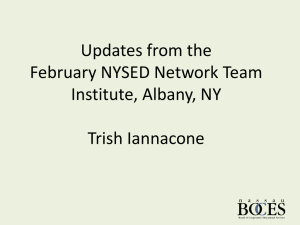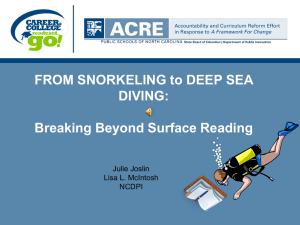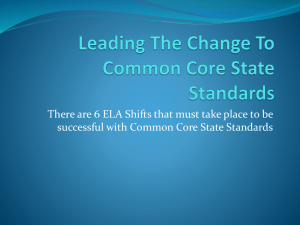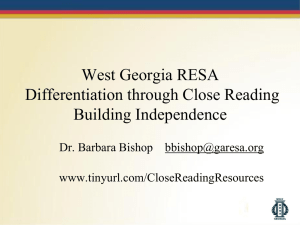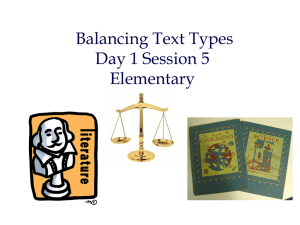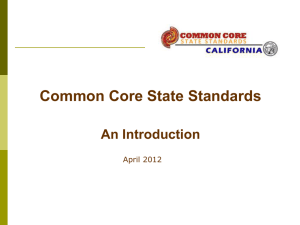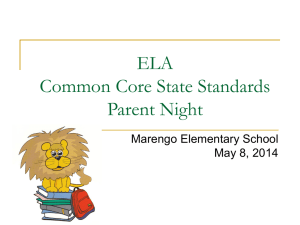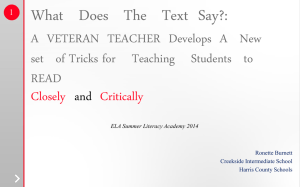Shifting Your View of Instruction through the Lens of the Common Core
advertisement
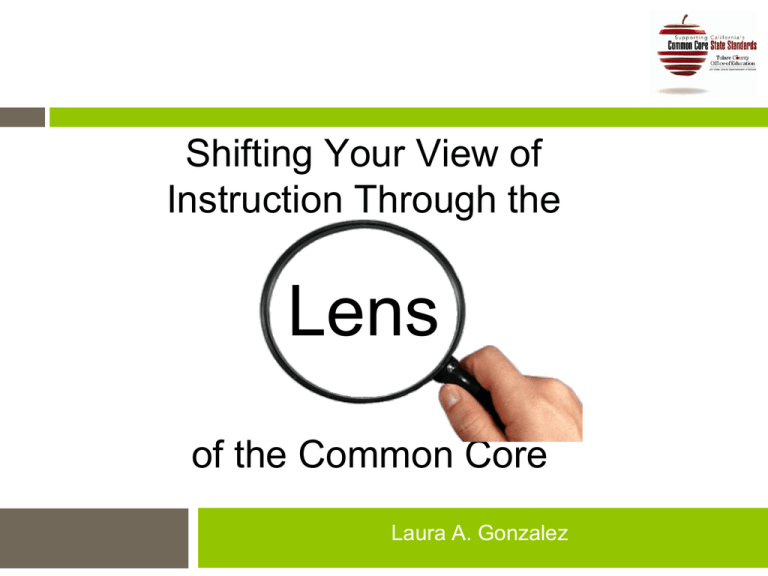
Shifting Your View of Instruction Through the Lens of the Common Core Laura A. Gonzalez Learning Outcomes • Understand the instructional shifts in ELA for the Common Core State Standards. • Participate in CCSS ELA Lesson Modules Norms 3 • Work collaboratively and draw on one another's strengths. • Foster a positive learning environment for all. • Use technology effectively. Quiz, Quiz, Trade • What do we know about the Common Core State Standards for ELA? 5 Supporting st 21 Century Skills Critical Thinking: Reflection, analysis, synthesis about a concept or idea for the purpose of gaining new knowledge. Creativity: Generating new ideas to solve problems Communication: Exchanging information Collaboration: Working together to accomplish a goal Tulare County Office of Education What’s In and What’s Out? IN OUT 1. Frequent encounters w/complex texts 1. Leveled texts (only) 2. Texts worthy of close attention 2. Reading any ‘ol text 3. Balance of literary and Info texts 3. Solely literature 4. Coherent sequences of texts 4. Collection of unrelated texts 5. Mostly text-dependent questions 5. Mostly text-to-self questions 6. Mainly evidence-based analyses 6. Mainly writing without sources 7. Accent on academic vocabulary 7. Accent on literary terminology 8. Emphasis on reading & re-reading 8. Emphasis on pre-reading 9. Reading strategies (as means) 9. Reading strategies (as end goal) 10. Reading foundations (central and integrated) 10. Reading foundations (peripheral and detached) Susan Pimentel, 2012 Instructional Examples Instead of Write a persuasive letter to your parents on why you should have a pet. Describe the events that led to the American Revolution. Ask students to Explain why a particular animal makes the best pet. Justify why the American Revolution was necessary. Susan Pimentel, 2012 7 www.achievethecore.org The Shifts Build Toward College and Career Readiness for All Students Literacy Across Disciplines CCSS does not just pertain to ELA but literacy across the disciplines of science, social studies, and technical subjects too. Red Flag/Green Flags Green Flags • Teach reading & writing in all content areas (SS, science, etc.) • Students write frequently about what they are reading and learning • Multiple texts • Primary sources Red Flags • Teacher presents what is in text, rather than students reading it • Text used as a reference rather than source of information • No connection between reading & writing assignments • A single text used Literature and Informational Texts Standards require certain percentages of literature and informational texts (modeled on NAEP) Grade Literary Informational 4 50% 50% 8 45% 55% 12 30% 70% Research Standards call for regular short research projects “Among the highest priorities of the Common Core Standards is that students can read closely and gain knowledge from texts.” Example from the Classroom How are students building strong content knowledge? What 21st Century Skills are the students using? What habits of mind are the students developing? http://vimeo.com/30418561 Process • Literacy Across Disciplines • Informational Text • Research Processing the ELA Shifts 15 Discuss • What implication does this shift have on classroom instruction? Citing Evidence Focus on students rigorously citing evidence from texts to support claims/inferences (Reading 1) Red Flag/Green Flags Green Flags • Rich/Rigorous conversations based on text • Students utilize information from text in their answers • Questions ask students to make inferences from evidence in text Red Flags • Questions can be answered without reading text • Questions are centered on students’ own experience • Students do not have to make connections to answer questions Observe this picture quietly. What has changed and what has stayed the same? Academic Talk Require purposeful academic talk (Speaking & Listening 1) “Among the highest priorities of the Common Core Standards is that students can read closely and gain knowledge from texts.” CCSS Emphasis in Writing Writing to Sources • Describe the connection between a series of historical events, scientific ideas or concepts, or steps in technical (RI.3) • Compare and contrast the most important points presented by two texts on the same topic.(RI.9) • Write informative/ explanatory texts in which they introduce a topic, use facts and definitions to develop points, and provide a concluding statement or section (W.2) Writing to Sources Require writing to sources rather than writing to de-contextualized expository prompts (Writing 9) Write a newspaper article defending why we should protect the owls in our environment. Process • Citing Evidence • Academic Talk • Writing to Sources Processing the ELA Shifts 24 Discuss • What implication does this shift have on classroom instruction? Engage with Complex Text Text Complexity Toward CCR Text at High End of Grade Band What students can read, in terms of complexity, is the greatest predictor of success in college. Text Between Middle and High End of Grade Band End of Year Text Near Middle of Grade Band Text Between Low End and Middle of Grade Band Text at Low End of Grade Band Beginning of Year www.achievethecore.org 25 Susan Pimentel, 2012 Red Flag/Green Flags Green Flags Red Flags • All students engage in same text • Appropriate scaffolding • Students are required to think critically about the text • Multiple text structures • Students always use leveled text • Students are given a summary of text prior to reading • No support offered for below grade level readers • Single text structure Engage with Complex Text Close Reading of Text • Standards reward careful, close reading rather than racing through texts • Highly focused pre-reading activities (no more than 10% of time spent reading) Susan Pimentel, 2012 www.achievethecore.org 27 Example from the Classroom Mr. Michaud mentions show and tell themes. How does this structure provide for more equitable discussions? How do the worksheet and Mr. Michaud's questioning provide scaffolding for student presentations? What other learning goals are addressed during this sharing time? How are students using academic vocabulary? Tulare County Office of Education https://www.teachingchannel.org/videos/show-and-tell-themes Example from the Classroom Teaching Channel – • How do the "guiding reflection questions" support students' thinking? Poetry Workstations • What skills are students practicing as they create their podcast? • How did the class blog contribute to collaboration among students? Common Core Standards ELA.RL.6.4, ELA.RL.6.7, ELA.SL.6.5 Close Reading Let’s practice! 1st read- Listen to the passage read aloud 2nd read- Take notes from the text read aloud 3rd step- Compare your notes with the notes that your partner took 4th step- Re-create the text with your partner Compare Take a Closer Look R.7 W.6, W.8 SL.2, SL.4, SL.5 Text Dependent Questions “A text dependent question specifically asks a question that can only be answered by referring explicitly back to the text being read” - http://ok.gov/sde/sites/ok.gov.sde/files/C3%20Guide-AnalyticReading.pdf 3 Types of TextDependent Questions • Questions that assess themes and central ideas • Questions that assess knowledge of vocabulary • Questions that assess syntax and structure 33 Non-Examples and Examples Not Text-Dependent Text-Dependent In “Casey at the Bat,” Casey strikes out. Describe a time when you failed at something. What makes Casey’s experiences at bat humorous? In “Letter from a Birmingham Jail,” Dr. King discusses nonviolent protest. Discuss, in writing, a time when you wanted to fight against something that you felt was unfair. What can you infer from King’s letter about the letter that he received? In “The Gettysburg Address” Lincoln says the nation is dedicated to the proposition that all men are created equal. Why is equality an important value to promote? “The Gettysburg Address” mentions the year 1776. According to Lincoln’s speech, why is this year significant to the events described in the speech? 34 “Close Reading” of a Stand-Alone Text © 2012 The Aspen Institute © 2012 The Aspen Institute Tools for Creating Text-Dependent Questions: Text-Dependent Question Worksheet A systematic approach to creating textdependent questions for complex texts while aligning them with the demands of the CCSS. © 2012 The Aspen Institute Activity • Read the opening of Brian Lies’ Bats at the Beach • With a partner, write one Text-Dependent Question for each stanza aligned to a CCSS anchor standard • Share your question with others at your table Evaluate your TDQ based on the samples provided Process • Text Complexity • Close Reading • Academic Language Academic Language Standards focus on the words that matter most—not obscure vocabulary but the academic language that pervades complex texts. Vocabulary Which words should be taught? • Essential to understanding text • Likely to appear in future reading Which words should get more time and attention? • More abstract words (as opposed to concrete words) persist vs. checkpoint noticed vs. accident • Words which are part of semantic word family secure, securely, security, secured 42 Source: Tulare County Office of Education Three Tiers of Vocabulary Instruction Source: ELA CCSS Appendix A; www.corestandards.org Tier One • These words are the words of everyday speech • While important they are not the focus • Usually not considered a challenge, but dog English Learners will need to attend to them school house food 45 Source: ELA CCSS Appendix A; www.corestandards.org Tier Three • Domain-specific words specific to a domain or field of study • Are key to understanding a new concept within text • Are specific • Have close ties to content knowledge • Are far more common in in informational text than in literary text • Recognized as new and hard words • Are explicitly defined by the author, repeatedly used, and heavily scaffolded (e.g., made a part of a glossary) molecule generation stalactite literary analysis 46 Source: ELA CCSS Appendix A; www.corestandards.org Tier Two • General Academic Words • Are far more likely to appear in written form than in speech • They appear in all sorts of texts: informational, technical, and literary • Often represent subtle or precise to say relatively simple things (saunter instead of walk) • They are highly generalizable inference similar analyze summarize compare 47 Source: ELA CCSS Appendix A; www.corestandards.org Source: ELA CCSS Appendix A; www.corestandards.org Identify & Classify Tiered Vocabulary in Context Source: ELA CCSS Appendix A; www.corestandards.org from CCSS Appendix A pages 34-35 Processing the ELA Shifts 52 Discuss • What implication does this shift have on classroom instruction? 53 Critical Thinking: Reflection, analysis, synthesis about a concept or idea for the purpose of gaining new knowledge. Creativity: Generating new ideas to solve problems Communication: Exchanging information Collaboration: Working together to accomplish a goal Tulare County Office of Education Review Sample Lesson Module “Nail Soup”– Close Reading and Inquiry Nail Soup Pair Share Focus Question According to the story, who is more dishonest, the soldier the old woman? Write or your answer. Circle words or passages that help answer the question. Incorporate The Use Of Language Frames Partner A - I believe ______ is more dishonest than ______ because ___________________. Partner B(if you agree) I likewise agree that ______ is more dishonest than ______ and I’ll add __________________. (if you disagree) I disagree. I believe ______ is more dishonest than ______ because ___________________. Round Table-Round Robin Discuss your answer with your partners. Come to consensus. Be ready to report out. Your turn Think of an upcoming story or topic • How can you incorporate text dependent questions? Opinion/Argument Writing Read Writing Standard one for your grade level ELA continuum p. 4 Writing CCR Standard #1 Write arguments to support claims in an analysis of substantive topics or texts, using valid reasoning and relevant and sufficient evidence. Examples from the Classroom Opinion Writing – Grade 2 • How did Miss Patterson engage her students in authentic inquiry? • In what ways did student interest contribute to the engagement of all students. • How did this activity prepare students for writing? http://www.youtube.com/watch?feature=player_detailpage&v=Icz4BrycFpo Example from the Classroom Brainstorming • How does Ms. Brewer tailor this lesson to the needs of English Language Learners? • What kinds of questions does Ms. Brewer ask to guide her students' discussions? • How does this activity prepare students for writing? https://www.teachingchannel.org/videos/analyzing-text-brainstorming Example from the Classroom Text Talk Time • What routines does Ms. Brewer have in place to help discussion run smoothly? • Notice the questions Ms. Brewer asks her class. What makes these questions rich? • Why is it beneficial to engage students in both small and large group discussions before writing? https://www.teachingchannel.org/videos/analyzing-text-as-a-group Example from the Classroom Text Analysis in Writing • What structures does Ms. Brewer have in place to allow for effective differentiation? • The class spent a lot of time talking before writing. What effect did this have? • When Ms. Brewer works with the small group, how does she support English Language Learners? https://www.teachingchannel.org/videos/analyzing-text-writing Brewer Video Triad • Process • Application • Planning 21st Century Skills Where Did We Communicate? 21st Century Skills Where Did We Collaborate? 21st Century Skills Where Did We Critically Think? 21st Century Skills Where Did We Create?
